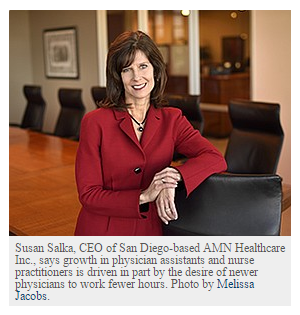
'The Physician Assistant Will See You Now'
 A new model of “team-based” patient care in San Diego County could fill the gaps left by doctor shortages as hospitals and medical groups divvy up responsibilities among less-costly support staff, such as physician assistants and nurse practitioners.The physician shortage problem has been a hotly contested topic among health care professionals with some claiming the shortage has the potential to threaten the future; others argue the impending doctor shortage is overblown.
A new model of “team-based” patient care in San Diego County could fill the gaps left by doctor shortages as hospitals and medical groups divvy up responsibilities among less-costly support staff, such as physician assistants and nurse practitioners.The physician shortage problem has been a hotly contested topic among health care professionals with some claiming the shortage has the potential to threaten the future; others argue the impending doctor shortage is overblown.
According to projections by the Association of American Medical Colleges, the nation will be short more than 90,000 physicians by 2020 and 130,000 physicians by 2025. Of that 130,000, the Annals of Family Medicine projected that 52,000 would be primary care doctors.San Diego-based AMN Healthcare Inc. is one of the largest health care staffing agencies in the nation, and President, Director and CEO Susan Salka said the doctor shortage is a result of several variables, from spiking patient volumes caused by the Affordable Care Act to shifting priorities for younger physicians.“Newer physicians are not looking to work as many hours as their older colleagues,” Salka said. “Primary care physicians who worked in solo practice or small groups used to work as many hours as needed to support their business. Younger physicians generally want more work-life balance - particularly if they’re being employed by a hospital system or medical group. This brings the average hours worked down per physician.”


